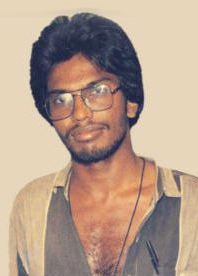Thileepan
Sri Lankan rebel (1960–1987) From Wikipedia, the free encyclopedia
Rasaiah Parthipan (Tamil: இராசையா பார்த்திபன்; 29 November 1963 – 26 September 1987; commonly known by the nom de guerre Thileepan) was a Tamil Eelam revolutionary and member of the Liberation Tigers of Tamil Eelam (LTTE), a separatist Tamil militant organisation in Sri Lanka. He died while on hunger strike.[2][3][4][5][6]
Early life and family
Parthipan was born on 29 November 1963.[7][8][a] He was from Urelu near Urumpirai in northern Ceylon.[11] His father was a Tamil teacher and he had three older brothers.[11] His mother died when Parthipan was three months old.[11] After his father died of diabetes he was brought up by his brothers.[11] He was educated at Jaffna Hindu College.[9][10][11] After school he enrolled in the University of Jaffna.[9][11]
LTTE
Summarize
Perspective
Parthipan joined the militant Liberation Tigers of Tamil Eelam (LTTE) prior to the 1983 Black July anti-Tamil riots.[10] He was given the nom de guerre Thileepan. Injured in the stomach in May 1987 during the Vadamarachchi Operation (Operation Liberation), he became the LTTE's political leader for Jaffna peninsula.[12][13]
As hostilities increased in northern Sri Lanka, the LTTE handed over a letter to the Indian High Commissioner on 13 September 1987 making five demands: the release of all political prisoners held under the Prevention of Terrorism Act and emergency regulations; cessation of Sinhalese colonisation of Tamil areas under the guise of "rehabilitation"; cessation of all "rehabilitation" activities until the establishment of the Interim Administrative Council; cessation of construction of police stations in the Northern and Eastern provinces; and the disarmament of Home Guards and withdrawal of the army/police from schools and colleges.[14][15][16][b] The demands were aimed at the Indian rather than the Sri Lankan government because the LTTE believed that Indians could force the Sri Lankans to comply.[16] The LTTE gave the Indians 24 hours to respond but no response, or even an acknowledgement, was received.[14]
Hunger strike
Determined to make the Indians meet the demands, Thileepan began a hunger strike on 15 September 1987 in front of Nallur Kandaswamy Temple.[15][19][20] Thileepan gave speeches which were broadcast on Nidharshanam, the LTTE's TV stations.[12][13] People from all over Jaffna peninsula came to observe and participate in the hunger strike.[12][13] On 22 September 1987 Indian High Commissioner J. N. Dixit arrived at Palaly Airport and was met by LTTE leader V. Prabhakaran who wanted Dixit to go and see Thileepan.[13] Dixit wanted a written guarantee from Prabhakaran that Thileepan would end his hunger strike if Dixit met with him but Prabhakaran couldn't give the guarantee.[13] As his condition deteriorated, Thileepan stopped giving speeches.[12] After refusing food or water for 12 days, Thileepan died on 26 September 1987.[15][21][22][23] After a "martyr's funeral" in Jaffna, Thileepan's body was handed over to the University of Jaffna's medical faculty.[12]
Aftermath
LTTE leader Prabhakaran accused India of betraying the Tamils after vowing to protect them.[24] Thileepan's death resulted in large anti-government and anti-Indian protests in northern Sri Lanka.[15][21][16]
Statues
A statue of Thileepan was built behind Nallur Kandaswamy Temple in 1988.[25][26] After the Sri Lankan military re-captured the Valikamam region in 1996 they destroyed the statue.[25][26] The statue was re-built in 2003 during the Norwegian mediated Cease Fire Agreement.[27] After war resumed, Thileepan's photograph and decorative lamps at the statue were damaged by the army on 26 October 2006.[25][26] Thileepan's statue was attacked and destroyed by armed men on 18 November 2007.[25] The remnants of Thileepan's memorial, the pillar, was destroyed by the army on 21 March 2010.[26]
Notes
- Sri Lankan sources falsely claim that Thileepan's hunger strike was a protest against the presence of the Indian Peace Keeping Force in Sri Lanka.[17][18]
References
External links
Wikiwand - on
Seamless Wikipedia browsing. On steroids.

